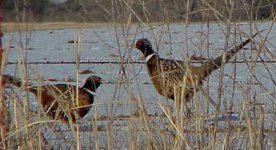SeniorCitizen
Well-known member
The Ring Neck, as I understand, was introduced into the United States from China. They seem to be well adapted and wide spread in this country. Does anyone have information approximately when they were imported to the U.S. and to which area initially?
This pic was taken by my wife, as we were slowly traveling the country side in the pick up truck enjoying nature, on the way to Roadrunner Ranch. The crouched bird readied himself, as the pickup stopped, in case flight is necessary. The light dusting of snow in the month of March along with the dormant grass and barbed (bob) wire fence made a great unique picture.
This pic was taken by my wife, as we were slowly traveling the country side in the pick up truck enjoying nature, on the way to Roadrunner Ranch. The crouched bird readied himself, as the pickup stopped, in case flight is necessary. The light dusting of snow in the month of March along with the dormant grass and barbed (bob) wire fence made a great unique picture.
Attachments
Last edited:





